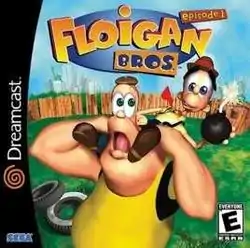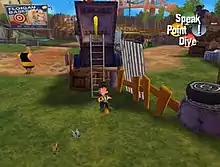Floigan Bros.
Floigan Bros. is an action-adventure video game developed by Visual Concepts released on July 30, 2001 by Sega. It starred Jason Marsden and Frank Welker as the voices of the title characters. It was released only for the Dreamcast after production of the console had ceased.
| Floigan Bros. | |
|---|---|
 North American Dreamcast cover art | |
| Developer(s) | Visual Concepts |
| Publisher(s) | Sega |
| Designer(s) | Andy Ashcraft Hirokazu Yasuhara |
| Composer(s) | Brian Luzietti |
| Platform(s) | Dreamcast |
| Release | |
| Genre(s) | Action-adventure |
Plot
The Floigan Brothers, Moigle and Hoigle, live by themselves in their very own junkyard. Moigle is the larger of the two brothers, and is not controlled by the player. Hoigle, on the other hand, is directly controlled by the player. The two act as opposites; Moigle is larger and dimwitted, while Hoigle is smaller and far more intelligent than his brother. Moigle decides to surprise his brother with a machine, the only catch is that the parts he needs are scattered around their junkyard. Thus, Hoigle and Moigle begin to look for parts to the machine by solving various puzzles. However, hovering above the junkyard in a blimp, is Baron Malodorous. He wants the junkyard for his own uses, and sends out his cat mercenaries to weed out the Floigan Brothers. By defeating the Baron's cats, the brothers can find the parts to Moigle's machine.[1]
Gameplay

Floigan Bros. is presented in a fully 3D environment in which the player is able to interact with almost everything. The setting is the brothers' junkyard and the surrounding areas such as the swamp, bluff, cavern and dog yard.[2] The player is in direct control of Hoigle for the entirety of the game. When there is something to be interacted with, commands will appear within the Dreamcast's button layout. Hoigle can perform a variety of tasks to solve a puzzle or defeat one of the Baron's cats. However, the interaction with Hoigle's brother, Moigle, is the highlighted feature of the game. The more badly he is treated, the less friendly and responsive he becomes to the player's commands.[3] The interactions with Moigle include hugging, punching him in the stomach, giving him something to eat and speaking to him.[4] Moigle goes through different emotions depending what happens to him. For instance, Moigle can come in contact with a spider, and will not do anything until his fears are subsided. Alternatively, getting Moigle angry will cause him to become more aggressive, and, in turn, be used for throwing Hoigle to previously unreachable places.[3] Another feature of Moigle is that the player can play short minigames with him to earn points. When enough points are collected, they can be used to make Moigle learn new skills, tricks and games.[4] These new actions can be to over come his fear of spiders, play with a yo-yo, and many others.[5] According to IGN, the game is very short and can be completed in an hour.[4]
Development
Floigan Bros. was in development in 1999 before the Dreamcast itself was even released but the game wasn't released until 2001, after production of the Dreamcast had ceased.[6] Sega confirmed that there were "developmental setbacks" during this time.[7]
During development Bernie Stolar, the president of SEGA said that "[Floigan Bros.] will do for SEGA what Mario did for Nintendo".[8]
The game's logo also has the words 'episode 1' on it, implying that it was meant to be the first of a series. This is backed up with an IGN interview with Visual Concepts' Greg Thomas where they repeatedly referred to the game as "the first installment", mentioned "further installments" and specifically in relation to additional episodes they said "Ultimately, we want to make as many of these as we can" and "Each new Floigan Bros. game would have its own storyline".[9]
Downloadable content (DLC) also existed but not all of the content was released due to the discontinuation of the Dreamcast and the games commercial failure. These were monthly DLC files which included mini games, mail, outfits, etc. The actual content was hidden on the game disc, but was unlocked when the player downloaded the DLC file. On March 10, 2017, Dreamcast-Live announced that the original developers released a modded version of the VMU save file to allow all of the content to be accessible for the first time ever. Dreamcast-Live has provided access to the DLC file.[10]
There was also the intention to allow for players to save and trade their Moigles using the VMU.[9]
Reception
| Aggregator | Score |
|---|---|
| Metacritic | 64/100(11 reviews)[11] |
IGN gave the game an 8.4 out of 10 but noted that the game was "woefully short".[4] Gamers Republic magazine praised the visuals and humour of the game, giving it 3 out of 5 stars.[2] Official Dreamcast Magazine (US) praised the interactions with Moigle but also stated that "some puzzles seemed a bit too obvious while some seemed too obscure".[3]
Jeff Lundrigan reviewed the Dreamcast version of the game for Next Generation, rating it three stars out of five, and stated that "This obviously needed to cook a bit longer."[12]
References
- Smotherman, Ryan (August 21, 2001). "Floigan Brothers". Gaming Target. Retrieved September 8, 2010.
- Halverson, Dave (August 2001). Gamers' Republic. p. 48.
- Shamoon, Evan (February 11, 2001). Official Sega Dreamcast. p. 44.
- IGN Staff (July 30, 2001). "Floigan Brothers". IGN. Retrieved June 28, 2019.
- nsorens (October 6, 2001). "An Interactive Cartoon". Epinions. Retrieved September 8, 2010.
- News, Mikel Reparaz 2007-07-24T02:40:54 204Z. "The Top 7... Franchise failures". gamesradar. Retrieved June 28, 2019.
- NextGen 67 Jul 2000. July 2000. pp. 18.
- IGN Unplugged - Issue 05 (2001-08)(IGN.com)(US). August 2001. pp. 32.
- IGN Staff (December 14, 2000). "IGNDC Interviews Visual Concepts' Greg Thomas". IGN. Retrieved June 28, 2019.
- https://www.dreamcastlive.net/blogs/post/All-Floigan-Bros-DLC-Released
- "Floigan Bros. Episode 1 on Metacritic".
- Lundrigan, Jeff (September 2001). "Finals". Next Generation. Vol. 4 no. 9. Imagine Media. p. 87.